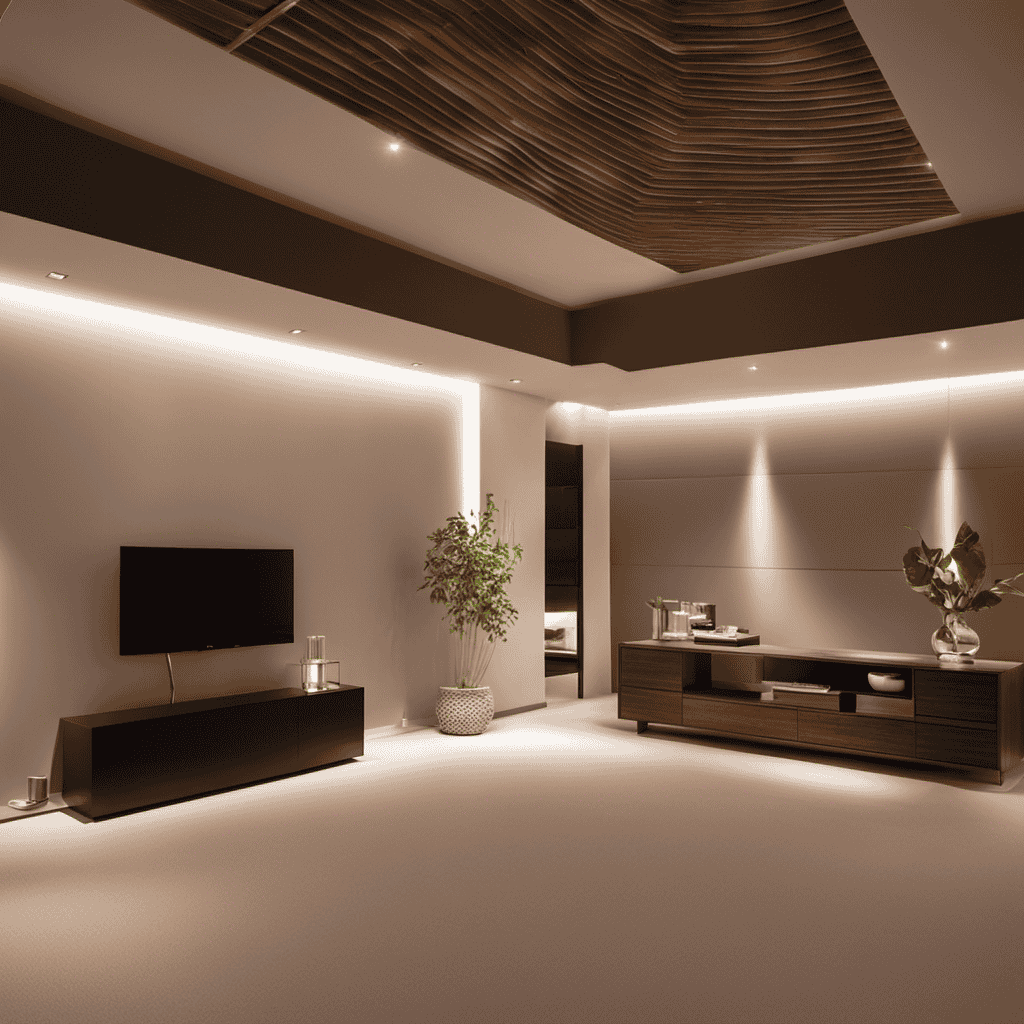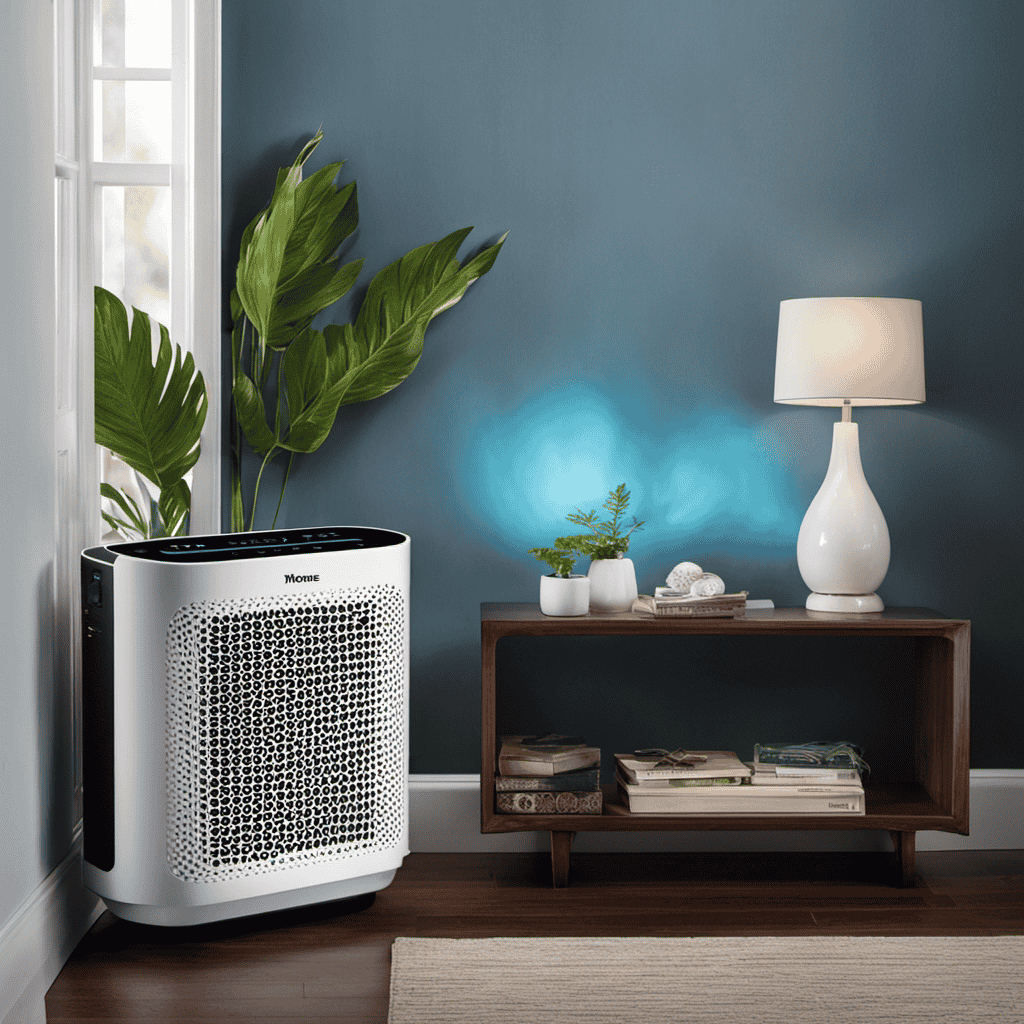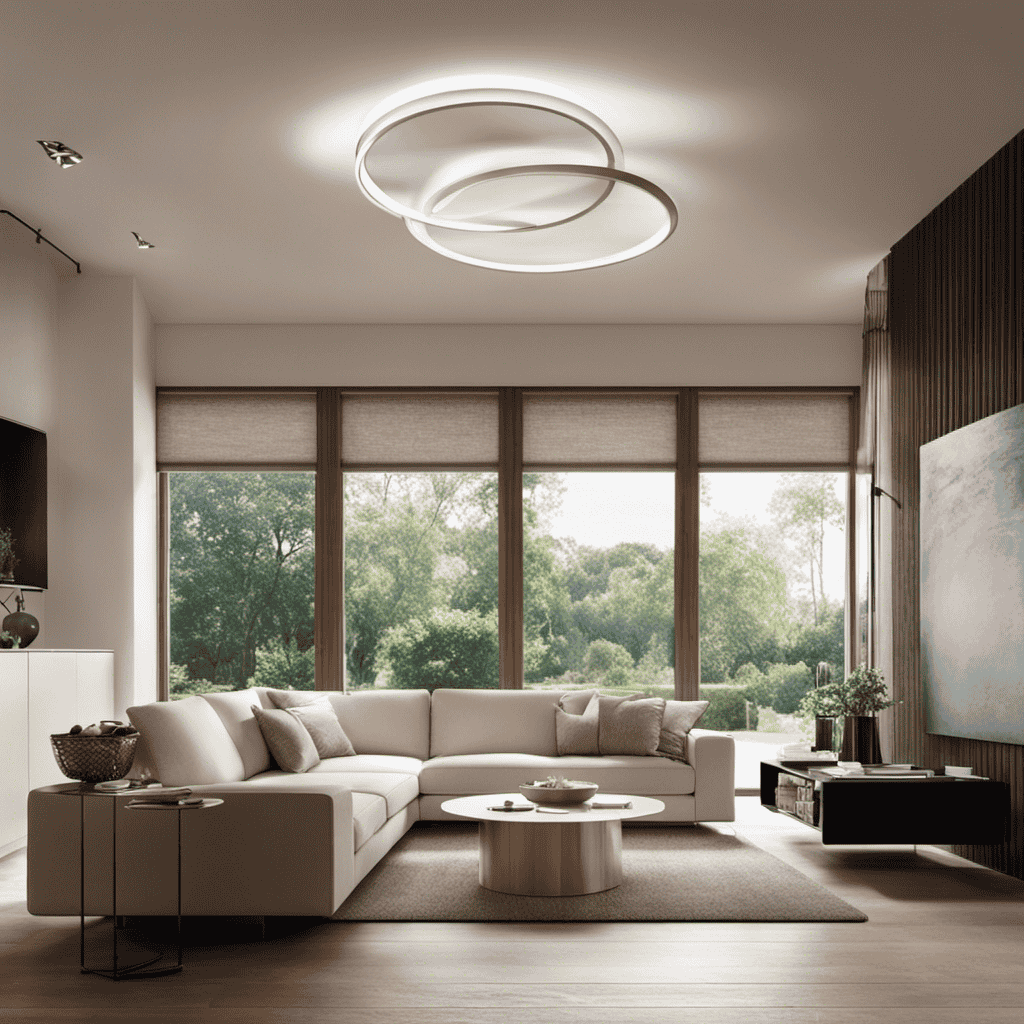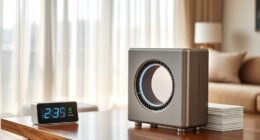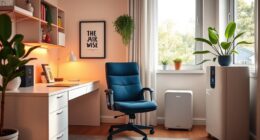If you're looking for the best air purifiers for large spaces and open floor plans, take into account the Levoit EverestAir. It covers 728 square feet and boasts a high Clean Air Delivery Rate (CADR) of 365 CFM, ensuring effective pollutant removal. The Smart Air Blast Mini is another great choice, offering coverage for 915 square feet while operating quietly at just 49 dB. Remember to check the filter lifespan and maintenance needs for ideal performance. Want to discover other top options and features to explore? There's more insight ahead to guide your decision!
Key Takeaways
- High CADR ratings are essential for effective air purification in large spaces, aiming for at least two-thirds of the room's size.
- Consider noise levels; models like Smart Air Blast Mini operate quietly at 49 dB, ideal for open floor plans.
- Choose air purifiers with long filter lifespans (12-15 months) to reduce maintenance frequency and costs.
- Multi-stage filtration systems, including HEPA and activated carbon filters, comprehensively target airborne particles and odors.
- Smart features, such as app integration and air quality sensors, enhance usability and adapt performance based on air quality conditions.
Top Air Purifier Recommendations
When it comes to choosing air purifiers for large spaces, you want options that are both effective and efficient. The Levoit EverestAir stands out as a top choice, covering 728 cubic feet in just 14 minutes with a CADR of 365 CFM. This model, along with others, showcases how air purifiers can greatly enhance indoor air quality, which can often be much worse than outdoor levels improve indoor air quality.
Priced at $499.99, it offers a filter life of 12-15 months. If you're looking for something quieter, the Smart Air Blast Mini operates at a mere 49 dB while handling rooms up to 915 sq. ft. Its CADR of 435 CFM and H13 HEPA filter lifespan of 13 months make it an excellent purifier for large rooms.
For budget-conscious consumers, consider the Levoit Core 600S at approximately $249.99. It efficiently cleans a 635 sq. ft. area with a CADR of 410 CFM. If you need an ionizer, the AirDoctor AD3000 is a great option for rooms up to 521 sq. ft., featuring a CADR of 339 CFM.
Key Performance Metrics

When choosing an air purifier for large spaces, you'll want to take into account key performance metrics like Clean Air Delivery Rate (CADR) and noise levels.
A higher CADR guarantees effective pollutant removal, which is essential for maintaining a healthy home environment, especially in areas where air quality may be compromised by home security systems that can also help enhance overall well-being.
Additionally, think about filter longevity, as longer-lasting filters can save you money and hassle in the long run.
Clean Air Delivery Rate
The Clean Air Delivery Rate (CADR) is an essential metric to reflect upon when selecting an air purifier for large spaces. It measures the volume of filtered air delivered by the unit, expressed in cubic feet per minute (CFM), and indicates how effectively it removes particles like smoke, dust, and pollen.
For ideal performance, you'll want a CADR rating that's at least two-thirds of your room size in square feet. For instance, if your space is 900 sq. ft., aim for a CADR around 600 CFM. Additionally, consider the air purifier's ability to operate quietly, which is especially important in open floor plans where noise can be disruptive during activities like yoga practice.
Higher CADR ratings mean faster air cleaning capabilities, making a large air purifier like the Smart Air Blast Mini, with a CADR of 435 CFM, an excellent choice for rooms up to 915 sq. ft.
The recommended air changes per hour (ACH) for effective purification in large rooms is around 4.8, meaning the air should be cleared nearly five times within an hour. This efficient air cleaning guarantees that you maintain a healthy environment, minimizing allergens and pollutants effectively.
Noise Level Considerations
Noise level is a crucial consideration in choosing an air purifier, especially for large spaces where sound can easily travel. You want an air purifier that maintains manageable noise levels to guarantee ideal comfort in your home.
For instance, many pet owners seek quiet solutions due to dog training techniques that require a peaceful environment. While some models, like the Smart Air Blast Mini, operate as quietly as 49 dB, others can reach high dB levels, even up to 63.6 dB, which is comparable to a vacuum cleaner.
For quiet spaces or nighttime use, it's advisable to choose air purifiers that keep noise levels below 50 dB to prevent sleep disruption.
Many air purifiers feature multiple fan speeds and automatic settings, allowing you to balance noise level with purification performance. Models like the Coway AP-1512HH provide a moderate noise level, guaranteeing effective air purification while remaining unobtrusive in your environment.
By selecting an air purifier with adjustable settings, you can customize the noise output according to your needs, making it easier to maintain a peaceful atmosphere.
Ultimately, finding the right balance between air quality and noise level can enhance your overall living experience in large, open spaces.
Filter Longevity Factors
Understanding filter longevity is vital for maximizing the effectiveness of your air purifier. Several factors influence how long your filters will last, including the frequency of use, air quality in your environment, and the types of pollutants present.
Typically, HEPA filters can last between 6 to 12 months under normal conditions, while activated carbon filters generally need replacement every 3 to 6 months, especially if you're dealing with strong odors or VOCs. Additionally, the efficiency of your air purifier can be influenced by eco-friendly energy sources, which contribute to better overall air quality in your space.
To extend filter longevity, regular maintenance is important. Cleaning pre-filters and monitoring filter indicators can help prolong the lifespan of your main HEPA filter, ensuring ideal performance.
Additionally, consider the design of your air purifier and its filtration system; efficient airflow dynamics can reduce how quickly filters become saturated with particles.
When choosing an air purifier, investing in models with long-lasting filters rated for 12 to 15 months can greatly reduce replacement costs and maintenance frequency. This not only saves you money in the long run but also enhances your overall convenience in maintaining air quality in your large spaces or open floor plans.
Choosing the Right Air Purifier

When you're picking an air purifier for a large space, start by considering the room size to guarantee you choose a model that can handle the area effectively.
Additionally, proper maintenance of air purifiers, like regularly replacing filters, plays an essential role in their efficiency and longevity; this is similar to how flushing issues stem from simple maintenance in toilets.
Next, think about the type of filters you need, as multi-stage filtration systems offer the best protection against allergens and pollutants.
Room Size Considerations
Choosing the right air purifier for your space is crucial to maintaining good air quality, especially in larger rooms. For spaces over 600 sq. ft., look for air purifiers with a high Clean Air Delivery Rate (CADR) to guarantee effective air changes.
Ideally, the CADR should cover about 2/3 of the room's square footage, which is key for peak performance. A thorough understanding of best practices in software quality assurance can enhance your decision-making when selecting an air purifier. Aim for an Air Changes per Hour (ACH) rate of 4.8; this will enhance filtration efficiency and boost pollutant removal.
If you have a large room, a CADR rating of at least 350 CFM is advisable. This rating allows the air purifier to effectively clean air in spaces up to 1,000 sq. ft. within 15-24 minutes.
When it comes to open floor plans, choose models that can cover at least 1,000 sq. ft. for proper airflow distribution. Additionally, opt for air purifiers with multi-stage filtration systems, including HEPA filters and activated carbon filters, to tackle a wide array of pollutants effectively. This guarantees thorough air purification and a healthier living environment.
Filter Type Selection
Selecting the right filter type for your air purifier is vital for maximizing its effectiveness in large spaces.
HEPA filters are a top choice, as they capture 99.97% of airborne particles as small as 0.3 microns, effectively removing allergens like dust, pollen, and pet dander.
For those with pets, choosing a unit with advanced filtration, similar to what's found in pet hair cleaning solutions, can further enhance performance by tackling additional allergens.
If you're concerned about odors and harmful gases, consider an activated carbon filter, which targets volatile organic compounds (VOCs) and enhances air quality.
To extend the life of your HEPA filters, pre-filters are essential. They catch larger particles, such as hair and lint, and are especially beneficial in high-traffic or pet-friendly large rooms.
For thorough air cleaning, look for multi-stage filtration systems that combine HEPA, activated carbon, and additional features like UV light to tackle diverse pollutants.
Noise Level Assessment
Finding the right balance between effective air purification and noise levels is vital, especially in large spaces where comfort matters. When choosing an air purifier, consider the decibel ratings, as they can greatly impact your overall experience.
Models like the Smart Air Blast Mini, operating at a maximum noise level of 49 dB, are ideal for open floor plans, guaranteeing quiet operation while maintaining efficient air purification. Additionally, it's worth noting that some air purifiers can benefit from the same principles of careful consideration as proper storage practices for butter, making certain that they remain effective over time.
It's important to keep in mind that purifiers with higher Clean Air Delivery Rate (CADR) ratings may produce more noise. As a result, you'll want to strike a balance between performance and acceptable noise levels to enhance user satisfaction.
Look for devices with multiple fan speeds, allowing you to adjust the noise levels according to your needs, whether you're working, relaxing, or sleeping.
In noise-sensitive environments, opting for a model with lower noise levels—typically around 40.2 dB on the lowest setting—can greatly improve your comfort.
Understanding CADR Ratings
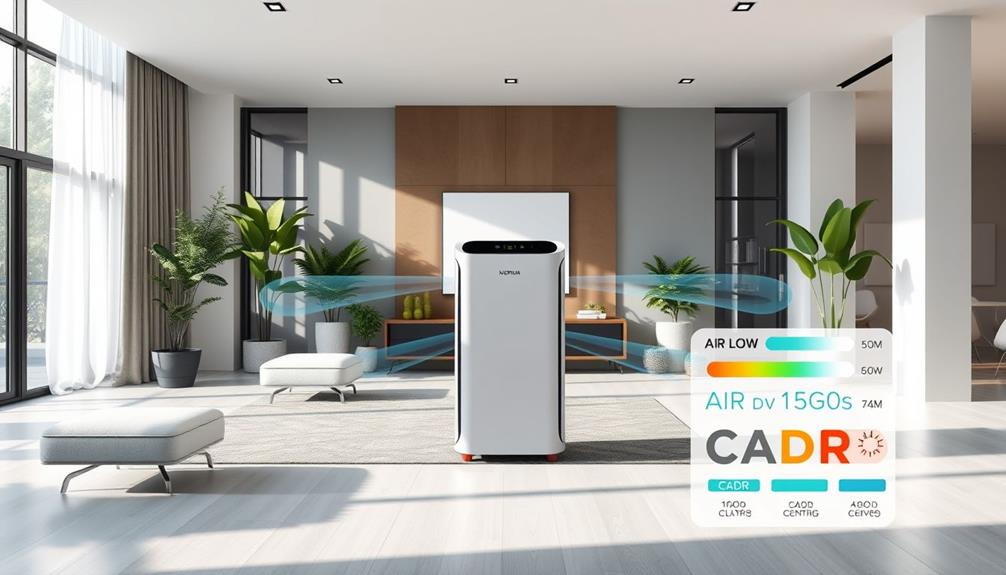
When you're shopping for an air purifier, understanding CADR ratings is vital for guaranteeing you're making a smart investment. CADR, or Clean Air Delivery Rate, measures how much clean air an air purifier delivers per minute. Higher CADR values indicate better performance in removing specific pollutants like smoke, dust, and pollen, which is significant when you're dealing with large spaces.
For homes with pets, for example, a vacuum with a self-cleaning brush roll can enhance air quality by efficiently collecting pet hair, thereby reducing allergens in the air self-cleaning brush roll.
To effectively clean the air, your purifier's CADR rating should be at least two-thirds of your room's square footage. For instance, if you have a 600 sq. ft. room, aim for a CADR of at least 400 CFM. This guarantees sufficient air changes per hour to maintain good air quality.
CADR ratings are standardized by the Association of Home Appliance Manufacturers (AHAM), making it easier for you to compare different air purifiers. Most high-performing models for large areas typically have CADR ratings ranging from 300 to 600 CFM, catering to various pollutants.
Noise Levels and Comfort

Comfort plays an essential role in your choice of air purifier, especially in large spaces where noise levels can impact your daily activities. When selecting an air purifier, consider its noise levels, particularly if you're sensitive to sound. Most models range from 40.2 dB at low settings to over 63.6 dB at maximum speed. For instance, the Levoit EverestAir operates at a moderate 53 dB, striking a balance between performance and comfort.
Many air purifiers come with multiple fan speed settings, enabling you to adjust noise levels according to your comfort needs while guaranteeing clean air. For tranquil situations, the Smart Air Blast Mini is designed for quiet operation, making it perfect for large areas where silence is preferred during work or sleep.
Here's a quick comparison of noise levels of popular models:
| Model | Noise Level (dB) |
|---|---|
| Levoit EverestAir | 53 |
| Smart Air Blast Mini | 40.2 |
| Maximum Speed (Generic) | 63.6 |
| Low Setting (Generic) | 40.2 |
| Medium Setting (Generic) | 50 |
Choosing the right model guarantees you maintain both air quality and comfort.
Long-Term Cost Considerations
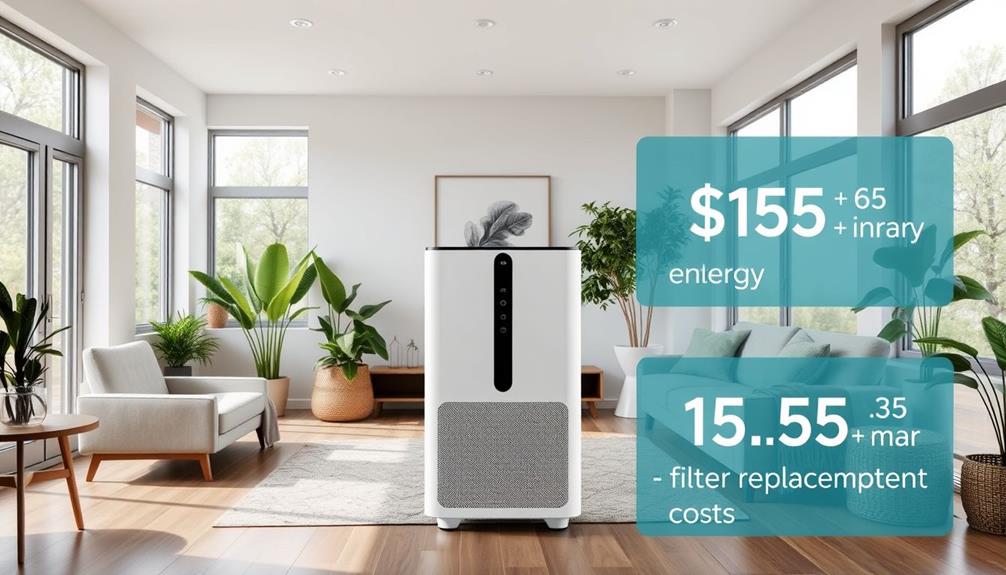
Investing in an air purifier for large spaces involves more than just the initial purchase price; you'll want to contemplate long-term running costs as well.
These expenses can vary considerably—budget options may cost around $125.13 annually, while high-end models like the IQAir HealthPro Plus can reach up to $421.47.
One major factor is filter replacement costs. For example, the Levoit Core 600S has an estimated replacement cost of about $60, whereas the Alen BreatheSmart 75i might incur higher costs due to its lifetime warranty and diverse filter options.
Energy consumption is another consideration, averaging around 36.7W across models. To calculate your electricity costs accurately, check your local rates, as this will affect your ongoing expenses.
Opting for units with longer filter lifespans, like the Smart Air Blast Mini, which lasts 13 months, can help minimize replacement frequency and costs.
Finally, don't forget potential maintenance costs associated with smart technology or app connectivity, which may involve occasional updates or troubleshooting.
Additional Features to Consider
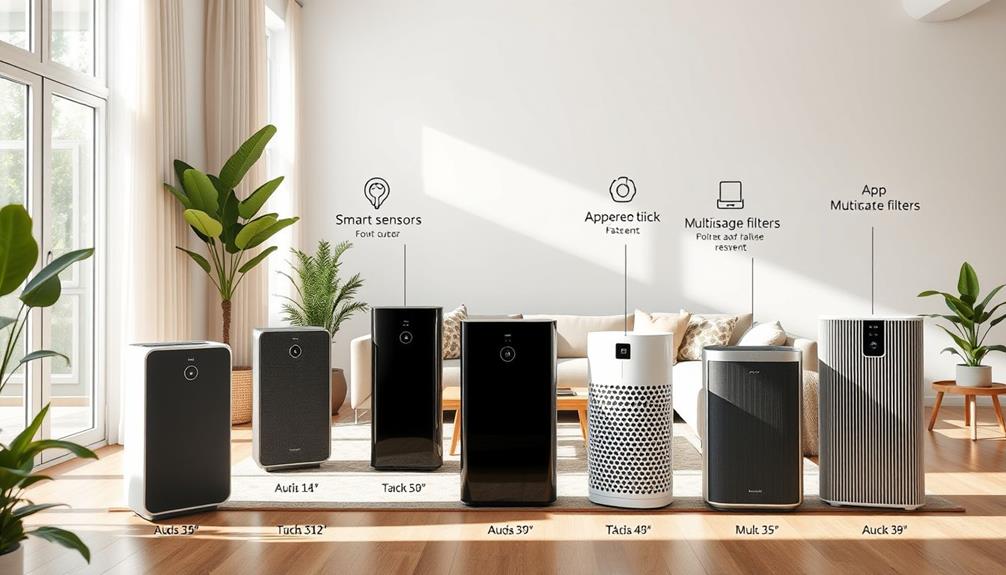
As you explore air purifiers for large spaces, it's vital to evaluate additional features that enhance usability and effectiveness.
Look for models equipped with smart technology, such as app integration and voice control, making it easy to monitor air quality from your smartphone. Filter replacement notifications are another important feature; they guarantee you're alerted when it's time to change your filters, keeping your purifier running efficiently.
Energy efficiency is a must; Energy Star-rated purifiers typically consume between 25W to 50W, saving you money on electricity bills.
Consider options with variable fan speeds, allowing you to tailor airflow and noise levels to your environment, especially if you need quiet operation at night.
An air quality sensor is a valuable addition, as it automatically adjusts the purifier's performance based on the current air quality.
Look for models with True HEPA filters to capture harmful allergens effectively.
Finally, pay attention to design and portability. Lightweight units can be easily moved between rooms, guaranteeing you have clean air wherever you go.
Auto mode is another convenient feature that optimizes operation without manual adjustments.
Conclusion
When it comes to finding the best air purifier for your large space, you can't afford to cut corners. By focusing on key performance metrics, CADR ratings, and noise levels, you'll inhale easier knowing you've made a smart choice. Remember to weigh long-term costs and additional features to guarantee you get the most bang for your buck. With the right air purifier, you'll create a refreshing atmosphere in your home, making it a haven of comfort and health.




